Lewis and Clark Expedition
Route of the expedition
President Thomas Jefferson commissioned the expedition shortly after the Louisiana Purchase in 1803 to explore and to map the newly acquired territory, to find a practical route across the western half of the continent, and to establish an American presence in this territory before Britain and other European powers tried to claim it. The campaign's secondary objectives were scientific and economic: to study the area's plants, animal life, and geography, and to establish trade with local American Indian tribes. The expedition returned to St. Louis to report its findings to Jefferson, with maps, sketches, and journals in hand.[2][3]
Contents
Overview
One of Thomas Jefferson's goals was to find "the most direct and practicable water communication across this continent, for the purposes of commerce." He also placed special importance on declaring US sovereignty over the land occupied by the many different Indian tribes along the Missouri River, and getting an accurate sense of the resources in the recently completed Louisiana Purchase.[4][5][6][7] The expedition made notable contributions to science,[8] but scientific research was not the main goal of the mission.[9]During the 19th century, references to Lewis and Clark "scarcely appeared" in history books, even during the United States Centennial in 1876, and the expedition was largely forgotten.[10][11] Lewis and Clark began to gain attention around the start of the 20th century. Both the 1904 Louisiana Purchase Exposition in St. Louis and the 1905 Lewis and Clark Centennial Exposition in Portland, Oregon showcased them as American pioneers. However, the story remained relatively shallow until mid-century as a celebration of US conquest and personal adventures, but more recently the expedition has been more thoroughly researched.[10]
In 2004, a complete and reliable set of the expedition's journals was compiled by Gary E. Moulton.[12][13][14] In the 2000s, the bicentennial of the expedition further elevated popular interest in Lewis and Clark.[11] As of 1984, no US exploration party was more famous, and no American expedition leaders are more recognizable by name.[10]
Timeline
| Timeline of the Lewis and Clark Expedition |
|---|
|
Lewis and Clark Expedition
May 1804 – September 1806
Return trip
|
Preparations
Jefferson met John Ledyard in Paris in the 1780s, and they discussed a possible trip to the Pacific Northwest.[19][20] Jefferson had also read Captain James Cook's A Voyage to the Pacific Ocean (London, 1784), an account of Cook's third voyage, and Le Page du Pratz's The History of Louisiana (London, 1763), all of which greatly influenced his decision to send an expedition. Like Captain Cook, he wished to discover a practical route through the Northwest to the Pacific coast. Alexander Mackenzie had already charted a route in his quest for the Pacific, following the Mackenzie River to the Arctic Ocean in 1789. Mackenzie and his party were the first to cross America north of Mexico to the Pacific when he arrived near Bella Coola, British Columbia in 1793—a dozen years before Lewis and Clark. Mackenzie's accounts in Voyages from Montreal (1801) informed Jefferson of Britain's intent to control the lucrative fur trade of the Columbia River and convinced him of the importance of securing the territory as soon as possible.[21][22]Two years into his presidency, Jefferson asked Congress to fund an expedition through the Louisiana territory to the Pacific Ocean. He did not attempt to make a secret of the Lewis and Clark expedition from Spanish, French, and British officials, but rather claimed different reasons for the venture. He used a secret message to ask for funding due to poor relations with the opposition Federalist Party in Congress.[23][24][25][26]
In 1803, Jefferson commissioned the Corps of Discovery and named Army Captain Meriwether Lewis its leader, who then selected William Clark as second in command. Lewis demonstrated remarkable skills and potential as a frontiersman, and Jefferson made efforts to prepare him for the long journey ahead as the expedition was gaining approval and funding.[27][28] Jefferson explained his choice of Lewis:
It was impossible to find a character who to a complete science in botany, natural history, mineralogy & astronomy, joined the firmness of constitution & character, prudence, habits adapted to the woods & a familiarity with the Indian manners and character, requisite for this undertaking. All the latter qualifications Capt. Lewis has.[29]In 1803, Jefferson sent Lewis to Philadelphia to study medicinal cures under Benjamin Rush, a physician and humanitarian. He also arranged for Lewis to be further educated by Andrew Ellicott, an astronomer who instructed him in the use of the sextant and other navigational instruments.[30][31] Lewis, however, was not ignorant of science and had demonstrated a marked capacity to learn, especially with Jefferson as his teacher. At Monticello, Jefferson possessed the largest library in the world on the subject of the geography of the North American continent, and Lewis had full access to it. He spent time consulting maps and books and conferring with Jefferson.
Lewis and Clark met near Louisville, Kentucky in October 1803 at the Falls of the Ohio and the core "Nine Young Men" were enlisted into the Corps of Discovery.[32][33] Their goals were to explore the vast territory acquired by the Louisiana Purchase and to establish trade and US sovereignty over the Indians along the Missouri River. Jefferson also wanted to establish a US claim of "discovery" to the Pacific Northwest and Oregon territory by documenting an American presence there before European nations could claim the land.[6][34][35][36] According to some historians, Jefferson understood that he would have a better claim of ownership to the Pacific Northwest if the team gathered scientific data on animals and plants.[37][38] However, his main objectives were centered around finding an all-water route to the Pacific coast and commerce. His instructions to the expedition stated:
The object of your mission is to explore the Missouri River, & such principle stream of it, as, by its course and communication with the waters of the Pacific ocean, whether the Columbia, Oregon, Colorado or any other river may offer the most direct & practicable water communication across this continent for the purpose of commerce.[39]The US mint prepared special silver medals with a portrait of Jefferson and inscribed with a message of friendship and peace, called Indian Peace Medals. The soldiers were to distribute them to the tribes that they met. The expedition also prepared advanced weapons to display their military firepower. Among these was an Austrian-made .46 caliber Girandoni air rifle, a repeating rifle with a 20-round tubular magazine that was powerful enough to kill a deer.[40][41][42] The expedition was prepared with flintlock firearms, knives, blacksmithing supplies, and cartography equipment. They also carried flags, gift bundles, medicine, and other items that they would need for their journey.[40][41]
The route of Lewis and Clark's expedition took them up the Missouri River to its headwaters, then on to the Pacific Ocean via the Columbia River, and it may have been influenced by the purported transcontinental journey of Moncacht-Apé by the same route about a century before. Jefferson had a copy of Le Page's book in his library detailing Moncacht-Apé's itinerary, and Lewis carried a copy with him during the expedition. Le Page's description of Moncacht-Apé's route across the continent neglects to mention the need to cross the Rocky Mountains, and it might be the source of Lewis and Clark's mistaken belief that they could easily carry boats from the Missouri's headwaters to the westward-flowing Columbia.[43]
Journey
Departure
Corps of Discovery meet Chinooks on the Lower Columbia, October 1805 (Charles Marion Russel, c. 1905)
The expedition followed the Missouri through what is now Kansas City, Missouri, and Omaha, Nebraska. On August 20, 1804, Sergeant Charles Floyd died, apparently from acute appendicitis. He had been among the first to sign up with the Corps of Discovery and was the only member to die during the expedition. He was buried at a bluff by the river, now named after him,[45] in what is now Sioux City, Iowa. His burial site was marked with a cedar post on which was inscribed his name and day of death. 1 mile (2 km) up the river, the expedition camped at a small river which they named Floyd's River.[46][47][48] During the final week of August, Lewis and Clark reached the edge of the Great Plains, a place abounding with elk, deer, bison, and beavers.
The Lewis and Clark Expedition established relations with two dozen Indian nations, without whose help the expedition would have risked starvation during the harsh winters and/or become hopelessly lost in the vast ranges of the Rocky Mountains.[49]
The Americans and the Lakota nation (whom the Americans called Sioux or "Teton-wan Sioux") had problems when they met, and there was a concern the two sides might fight. According to Harry W. Fritz, "All earlier Missouri River travelers had warned of this powerful and aggressive tribe, determined to block free trade on the river. ... The Sioux were also expecting a retaliatory raid from the Omaha Indians, to the south. A recent Sioux raid had killed 75 Omaha men, burned 40 lodges, and taken four dozen prisoners."[50]
Reconstruction of Fort Mandan, Lewis and Clark Memorial Park, North Dakota
In the winter of 1804–05, the party built Fort Mandan, near present-day Washburn, North Dakota. Just before departing on April 7, 1805, the expedition sent the keelboat back to St. Louis with a sample of specimens, some never seen before east of the Mississippi.[55] One chief asked Lewis and Clark to provide a boat for passage through their national territory. As tensions increased, Lewis and Clark prepared to fight, but the two sides fell back in the end. The Americans quickly continued westward (upriver), and camped for the winter in the Mandan nation's territory.
After the expedition had set up camp, nearby Indians came to visit in fair numbers, some staying all night. For several days, Lewis and Clark met in council with Mandan chiefs. Here they met a French-Canadian fur trapper named Toussaint Charbonneau, and his young Shoshone wife Sacagawea. Charbonneau at this time began to serve as the expedition's translator. Peace was established between the expedition and the Mandan chiefs with the sharing of a Mandan ceremonial pipe.[56] By April 25, Captain Lewis wrote his progress report of the expedition's activities and observations of the Indian nations they have encountered to date: A Statistical view of the Indian nations inhabiting the Territory of Louisiana, which outlined the names of various tribes, their locations, trading practices, and water routes used, among other things. President Jefferson would later present this report to Congress.[57]
Lewis and Clark Meeting the Salish in Ross Hole, September 4, 1805.
Pacific Ocean
The expedition sighted the Pacific Ocean for the first time on November 7, 1805, arriving two weeks later.[59][60] The expedition faced its second bitter winter camped on the north side of the Columbia River, in a storm-wracked area.[59] Lack of food was a major factor. The elk, the party's main source of food, had retreated from their usual haunts into the mountains, and the party was now too poor to purchase enough food from neighboring tribes.[61] On November 24, 1805, the party voted to move their camp to the south side of the Columbia River near modern Astoria, Oregon. Sacagawea, and Clark's slave York, were both allowed to participate in the vote, so this may have been the first time in American history where a woman and a slave were allowed to vote.[62]On the south side of the Columbia River, 2 miles (3 km) upstream on the west side of the Netul River (now Lewis and Clark River), they constructed Fort Clatsop.[59] They did this not just for shelter and protection, but also to officially establish the American presence there, with the American flag flying over the fort.[52][63] During the winter at Fort Clatsop, Lewis committed himself to writing. He filled many pages of his journals with valuable knowledge, mostly about botany, because of the abundant growth and forests that covered that part of the continent.[64] The health of the men also became a problem, with many suffering from colds and influenza.[61]
Return trip
Lewis was determined to remain at the fort until April 1, but was still anxious to move out at the earliest opportunity. By March 22, the stormy weather had subsided and the following morning, on March 23, 1806, the journey home began. The Corps began their journey homeward using canoes to ascend the Columbia River, and later by trekking over land.[65][66]They made their way to Camp Chopunnish[note 1] in Idaho, along the north bank of the Clearwater River, where the members of the expedition collected 65 horses in preparation to cross the Bitterroot Mountains, lying between modern-day Idaho and western Montana. However, the range was still covered in snow, which prevented the expedition from making the crossing. On April 11, while the Corps was waiting for the snow to diminish, Lewis' dog, Seaman, was stolen by Indians, but was retrieved shortly. Worried that other such acts might follow, Lewis warned the chief that any other wrongdoing or mischievous acts would result in instant death.
On July 3, before crossing the Continental Divide, the Corps split into two teams so Lewis could explore the Marias River. Lewis' group of four met some men from the Blackfeet nation. During the night, the Blackfeet tried to steal their weapons. In the struggle, the soldiers killed two Blackfeet men. Lewis, George Drouillard, and the Field brothers fled over 100 miles (160 kilometres) in a day before they camped again.
Meanwhile, Clark had entered the Crow tribe's territory. In the night, half of Clark's horses disappeared, but not a single Crow had been seen. Lewis and Clark stayed separated until they reached the Yellowstone and Missouri Rivers on August 11. As the groups reunited, one of Clark's hunters, Pierre Cruzatte, mistook Lewis for an elk and fired, injuring Lewis in the thigh.[67] Once together, the Corps was able to return home quickly via the Missouri River. They reached St. Louis on September 23, 1806.[68]
Spanish interference
In March 1804, before the expedition began in May, the Spanish in New Mexico learned from General James Wilkinson[note 2] that the Americans were encroaching on territory claimed by Spain. After the Lewis and Clark expedition set off in May, the Spanish sent four armed expeditions of 52 soldiers, mercenaries, and Indians on August 1, 1804 from Santa Fe, New Mexico northward under Pedro Vial and José Jarvet to intercept Lewis and Clark and imprison the entire expedition. They reached the Pawnee settlement on the Platte River in central Nebraska and learned that the expedition had been there many days before. The expedition was covering 70 to 80 miles (110 to 130 km) a day and Vial's attempt to intercept them was unsuccessful.[69][70]Geography and science
Map
of Lewis and Clark's expedition: It changed mapping of northwest
America by providing the first accurate depiction of the relationship of
the sources of the Columbia and Missouri Rivers, and the Rocky
Mountains around 1814
The expedition documented natural resources and plants that had been previously unknown to Euro-Americans, though not to the indigenous peoples.[72] Lewis and Clark were the first Americans to cross the Continental Divide, and the first Americans to see Yellowstone, enter into Montana, and produce an official description of these different regions.[73][74] Their visit to the Pacific Northwest, maps, and proclamations of sovereignty with medals and flags were legal steps needed to claim title to each indigenous nation's lands under the Doctrine of Discovery.[75]
The expedition was sponsored by the American Philosophical Society (APS).[76] Lewis and Clark received some instruction in astronomy, botany, climatology, ethnology, geography, meteorology, mineralogy, ornithology, and zoology.[77] During the expedition, they made contact with over 70 Native American tribes and described more than 200 new plant and animal species.[78]
Jefferson had the expedition declare "sovereignty" and demonstrate their military strength to ensure native tribes would be subordinate to the U.S., as European colonizers did elsewhere. After the expedition, the maps that were produced allowed the further discovery and settlement of this vast territory in the years that followed.[79][80]
In 1807, Patrick Gass, a private in the U.S. Army, published an account of the journey. He was promoted to sergeant during the course of the expedition.[81] Paul Allen edited a two-volume history of the Lewis and Clark expedition that was published in 1814, in Philadelphia, but without mention of the actual author, banker Nicholas Biddle.[82] [note 3] Even then, the complete report was not made public until more recently.[83] The earliest authorized edition of the Lewis and Clark journals resides in the Maureen and Mike Mansfield Library at the University of Montana.
Encounters with American Indians
One of the primary objectives of the expedition as directed by President Jefferson was to observe and record the whereabouts, lives, activities, and cultures of the various American Indian tribes that inhabited the newly acquired territory and the northwest in general. The expedition encountered many different tribes along the way, many of whom offered their assistance, providing the expedition with their knowledge of the wilderness and with the acquisition of food. The expedition had blank leather-bound journals and ink for the purpose of recording such encounters, as well as for scientific and geological information. They were also provided with various gifts of medals, ribbons, needles, mirrors, and other articles which were intended to ease any tensions when negotiating their passage with the various Indian chiefs whom they would encounter along their way.[84][85][86][87]Many of the tribes had friendly experiences with British and French fur traders in various isolated encounters along the Missouri and Columbia Rivers, and the expedition did not encounter any hostilities with the exception of the Teton-Sioux tribe under Black Buffalo and the Partisan tribe on September 25, 1804. Both of these tribes were rivals and hoped to use the expedition to their own advantage, and both demanded tribute from the expedition for their passage over the river.[84][85][86][87]
Captain Lewis made his first mistake by offering the Sioux chief gifts first, which insulted and angered the Partisan chief. Communication was difficult, since the expedition's only Sioux interpreter was Pierre Dorion who had stayed behind with the other party and was also involved with diplomatic affairs with another tribe. Consequently, both chiefs were offered a few gifts, but neither was satisfied. At that point, some of the warriors from the Partisan tribe took hold of their boat and one of the oars. Lewis took a firm stand, ordering a display of force and presenting arms; Captain Clark brandished his sword and threatened violent reprisal. Just before the situation erupted into a violent confrontation, Black Buffalo ordered his warriors to back off.[84][85][86][87]
The captains were able to negotiate their passage without further incident with the aid of better gifts and a bottle of whiskey. During the next two days, the expedition made camp not far from Black Buffalo's tribe. Similar incidents occurred when they tried to leave, but trouble was averted with gifts of tobacco.[84][85][86][87]
Observations
As the expedition encountered the various American Indian tribes during the course of their journey they observed and recorded information regarding their lifestyles, customs and the social codes they lived by, as directed by President Jefferson. By western standards the Indian way of life seemed harsh and unforgiving as witnessed by members of the expedition. After many encounters and camping in close proximity to the Indian nations for extended periods of time during the winter months they soon learned first hand of their customs and social orders.One of the primary customs that distinguished Indian cultures from those of the West was that it was customary for the men to take on two or more wives if they were able to provide for them and often took on a wife or wives who were members of the immediate family circle. e.g. men in the Minnetaree [note 4] and Mandan tribes would often take on a sister for a wife. Chastity among women was not held in high regard. Infant daughters were often sold by the father to men who were grown, usually for horses or mules.
They learned that women in Sioux nations were often bartered away for horses or other supplies, yet this was not practiced among the Shoshone nation who held their women in higher regard.[88] They witnessed that many of the Indian nations were constantly at war with other tribes, especially the Sioux, who, while remaining generally friendly to the white fur traders, had proudly boasted and justified the almost complete destruction of the once great Cahokia nation, along with the Missouris, Illinois, Kaskaskia, and Piorias tribes that lived about the countryside adjacent to the upper Mississippi and Missouri rivers.[89]
Sacagawea
Statue of Sacagawea, a Shoshone woman who accompanied the Lewis and Clark Expedition
On February 11, 1805, a few weeks after her first contact with the expedition, Sacagawea went into labor which was slow and painful, so the Frenchman Charbonneau suggested she be given a potion of rattlesnake's rattle to aid in her delivery. Lewis happened to have some snake's rattle with him. A short time after administering the potion, she delivered a healthy boy who was given the name Jean Baptiste Charbonneau.[90][91]
When the expedition reached Marias River, on June 16, 1805, Sacagawea became dangerously ill. She was able to find some relief by drinking mineral water from the sulphur spring that fed into the river.[92]
Though she has been discussed in literature frequently, much of the information is exaggeration or fiction. Scholars say she did notice some geographical features, but "Sacagawea ... was not the guide for the Expedition, she was important to them as an interpreter and in other ways."[93] The sight of a woman and her infant son would have been reassuring to some indigenous nations, and she played an important role in diplomatic relations by talking to chiefs, easing tensions, and giving the impression of a peaceful mission.[94][95]
In his writings, Meriwether Lewis presented a somewhat negative view of her, though Clark had a higher regard for her, and provided some support for her children in subsequent years. In the journals, they used the terms "squar" and "savages" to refer to Sacagawea and other indigenous peoples.[96]
Accomplishments
The Corps met their objective of reaching the Pacific, mapping and establishing their presence for a legal claim to the land. They established diplomatic relations and trade with at least two dozen indigenous nations. They did not find a continuous waterway to the Pacific Ocean[97] but located an Indian trail that led from the upper end of the Missouri River to the Columbia River which ran to the Pacific Ocean.[98] They gained information about the natural habitat, flora and fauna, bringing back various plant, seed and mineral specimens. They mapped the topography of the land, designating the location of mountain ranges, rivers and the many Indian tribes during the course of their journey. They also learned and recorded much about the language and customs of the American Indian tribes they encountered, and brought back many of their artifacts, including bows, clothing and ceremonial robes.[99]Aftermath
Lewis and Clark returned from their expedition, bringing with them the Mandan Indian Chief Shehaka from the Upper Missouri to visit the "Great Father" at Washington City. After Chief Shehaka's visit, it required multiple attempts and multiple military expeditions to safely return Shehaka to his nation.
Legacy and honors
Since the expedition, Lewis and Clark have been commemorated and honored over the years on various coins, currency, and commemorative postage stamps, as well as in a number of other capacities.- Lewis & Clark were honored (along with the American bison) on the Series of 1901 $10 Legal Tender
- Lewis and Clark Interpretive Center in Cape Disappointment State Park
Prior discoveries
In 1682, René-Robert Cavelier, Sieur de La Salle went down the Mississippi from the Great Lakes to the Gulf. The French then established a chain of posts along the Mississippi from New Orleans to the Great Lakes. There followed a number of French explorers including Pedro Vial and Pierre Antoine and Paul Mallet, among others. Vial may have preceded Lewis and Clark to Montana. In 1787, he gave a map of the upper Missouri River and locations of "territories transited by Pedro Vial" to Spanish authorities.[102]Early in 1792, the American explorer Robert Gray, sailing in the Columbia Rediviva, discovered the yet to be named Columbia River, named it after his ship and claimed it for the United States. Later in 1792, the Vancouver Expedition had learned of Gray's discovery and used his maps. Vancouver's expedition explored over 100 miles (160 km) up the Columbia, into the Columbia River Gorge. Lewis and Clark used the maps produced by these expeditions when they descended the lower Columbia to the Pacific coast.[103][104]
From 1792–93 Alexander Mackenzie had crossed North America from Quebec to the Pacific.[105]
See also
| Wikimedia Commons has media related to Lewis and Clark National Historic Trail. |
| Wikimedia Commons has media related to Lewis and Clark Trail. |
| Wikimedia Commons has media related to Lewis and Clark Expedition. |
- Lewis and Clark's Keelboat
- The Red River Expedition (1806) and the Pike Expedition were also commissioned by Jefferson
- Gateway Arch National Park
- The Far Horizons, a movie of the expedition
- York (explorer) – the slave on the expedition
- Lewis and Clark Pass (Montana) – the only non-motorized pass on the expedition's route


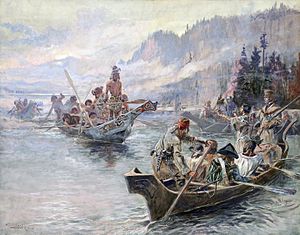




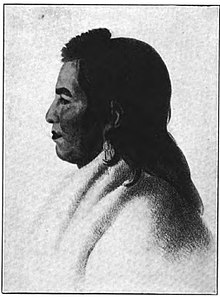


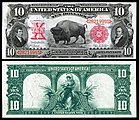
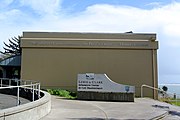
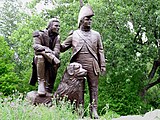

No comments:
Post a Comment